Related Research Articles
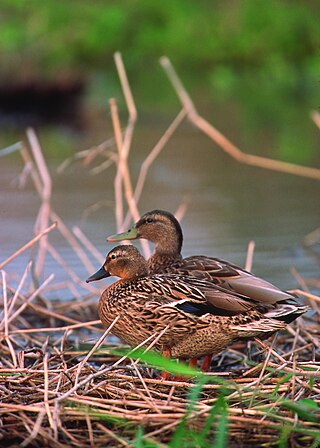
The Hawaiian duck or koloa is a species of bird in the family Anatidae that is endemic to the large islands of Hawaiʻi. Taxonomically, the koloa is closely allied with the mallard. It differs in that it is monochromatic and non-migratory. As with many duck species in the genus Anas, Hawaiian duck and mallards can interbreed and produce viable offspring, and the koloa has previously been considered an island subspecies of the mallard. However, all major authorities now consider this form to be a distinct species within the mallard complex. Recent analyses indicate that this is a distinct species that arose through ancient hybridization between mallard and the Laysan duck. The native Hawaiian name for this duck is koloa maoli, or simply koloa. This species is listed as endangered by the IUCN Red List of Threatened Species, and its population trend is decreasing.
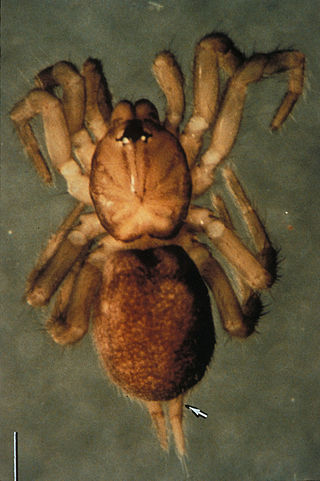
The spruce-fir moss spider is an endangered species of spider found at high elevations in the southern Appalachian Mountains. First identified in 1923, it inhabits moss that grows on rocks underneath the forest canopy.
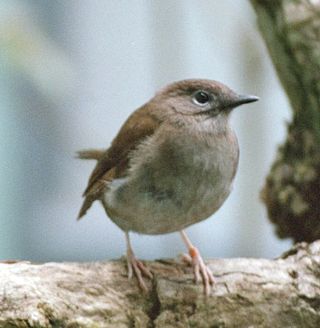
The puaiohi, or small Kauaʻi thrush, is a rare species of songbird in the thrush family, Turdidae, that is endemic to the Hawaiian island of Kauaʻi. It is closely related to the other three endemic Hawaiian thrushes, the kāmaʻo, olomaʻo, and ʻōmaʻo. It was first collected by Henry Palmer in 1891 at Halemanu around the entrance to the Kōkeʻe State Park.

The Kauaʻi ʻōʻō or ʻōʻōʻāʻā was the last member of the ʻōʻō (Moho) genus within the Mohoidae family of birds from the islands of Hawaiʻi. The entire family is now extinct. It was previously regarded as a member of the Australo-Pacific honeyeaters.

A near-threatened species is a species which has been categorized as "Near Threatened" (NT) by the International Union for Conservation of Nature (IUCN) as that may be vulnerable to endangerment in the near future, but it does not currently qualify for the threatened status.

The Kauaʻi cave wolf spider, also known to local residents as the blind spider, is only known to occur in a few caves in a lava flow with an area of 10.5 km2 (4.1 sq mi) in the Kōloa–Poʻipū region of Kauaʻi, Hawaiian Islands, and only six populations are known to exist. While their nearest surface-dwelling relatives have large eyes, this species has completely lost its eyes. They reach a body length around 20 mm (0.8 in), and are reddish brown and completely harmless to people. Unlike most wolf spiders, it produces only 15 to 30 eggs per clutch. The female carries the egg sac in her mouthparts until the spiderlings hatch.
Threatened arthropods are defined here as any of a number of species within the phylum Arthropoda, whose extinction is likely in the foreseeable future. Estimating the number of threatened arthropod species is extremely difficult, primarily because a vast number of the species themselves are not yet named or described. Furthermore, according to Deyrup and Eisner, "The rate of destruction and degradation of natural habitats is currently so great that there are not nearly enough biologists to even catalog the arthropod species that are suddenly on the edge of extinction." In any case, independent estimates indicate that there are millions of undocumented arthropods on Earth.
Spelaeorchestia koloana, the Kauaʻi cave amphipod or ʻuku noho ana in Hawaiian, is a cave-dwelling crustacean only found on the Hawaiian island of Kauaʻi. It is eyeless and measures 7–10 mm (0.28–0.39 in) long. It is only known from 10 populations, and eats decaying plant matter and other decomposing material.

The Kauai ʻakialoa was a Hawaiian honeycreeper in the subfamily Carduelinae of the family Fringillidae. It was endemic to the island of Kauai, Hawaii. It became extinct in the 20th century due to introduced avian disease and habitat loss. The Kauai ʻakialoa was about seven and a half inches in length and had a very long downcurved bill, which covered one third of its length. The adult males were bright olive-yellow on top and yellow on the bottom. The throat, breast, and sides of the body were olive-yellow. The females, however, were green-gray above and had a shorter bill.
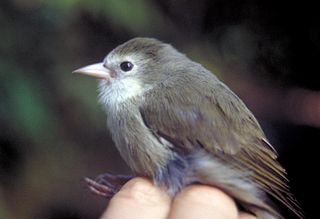
The ʻakikiki, also called the Kauaʻi creeper, is a critically endangered Hawaiian honeycreeper endemic to Kauaʻi, Hawaiʻi. It is the only member of the genus Oreomystis. Of the Hawaiian birds known to be extant, it is thought to be the most endangered, with only 454 wild individuals known as of 2018. A survey report in 2021 estimated the population at 45 with a 5 percent annual decrease, and in July 2023 the remaining number of wild birds was estimated to be just 5 individuals. This species is predicted to be extinct in the wild in 2023.

The richness and variety of the wildlife of Ethiopia is dictated by the great diversity of terrain with wide variations in climate, soils, natural vegetation and settlement patterns. Ethiopia contains a vast highland complex of mountains and dissected plateaus divided by the Great Rift Valley, which runs generally southwest to northeast and is surrounded by lowlands, steppes, or semi-desert.

The kāmaʻo or large Kauaʻi thrush was a small, dark solitaire endemic to Kauaʻi in the Hawaiian Islands.

The great raft spider or fen raft spider is a European species of spider in the family Pisauridae. Like other Dolomedes spiders, it is semiaquatic, hunting its prey on the surface of water. It occurs mainly in neutral to alkaline, unpolluted water of fens and grazing marsh.

The Kauaʻi nukupuʻu was a species of nukupuʻu once found throughout parts of the Hawaiian island of Kauaʻi. It was an insect eater that picked out its tiny prey from tree bark. The males were yellowish with brown wings, while the females were grayish brown with a yellow throat streak.

The Makauwahi Cave is the largest limestone cave found in Hawaii. It lies on the south coast of the island of Kauaʻi, in the Māhāʻulepū Valley close to Māhāʻulepū Beach, and is important for its paleoecological and archaeological values. It is reached via a sinkhole and has been described as “…maybe the richest fossil site in the Hawaiian Islands, perhaps in the entire Pacific Island region”.

Texella reyesi is a rare species of arachnid known by the common name Bone Cave harvestman. It is endemic to Texas in the United States, where it lives in limestone caves in Travis and Williamson Counties. It is threatened by the loss of its habitat. It is a federally listed endangered species of the United States.
List of threatened and endangered arthropods, including insects, arachnids, and crustaceans under the United States Endangered Species Act as of October 2013.
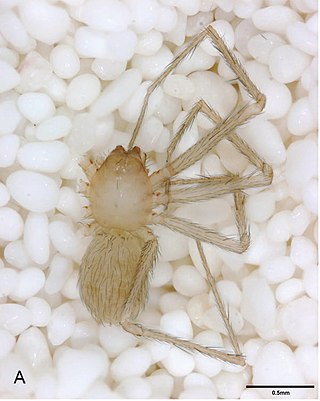
Tayshaneta microps, synonym Neoleptoneta microps, is a rare species of spider in the family Leptonetidae known by the common name Government Canyon bat cave spider. It is endemic to Texas in the United States, where it is known to be found in two caves in Bexar County. It is a troglobite, an animal which spends its entire life in caves. It is one of nine Bexar County troglobites which were listed as endangered species in 2000.

The Tooth Cave pseudoscorpion(Tartarocreagris texana) is a small cave-dwelling arachnid of the family Neobisiidae. The species was originally assigned to the genus Microcreagris, and then reassigned to Austalillocregris before arriving at its current genus, Tartarocreagris. The Tooth Cave pseudoscorpion has a small geographic distribution, known to occur in only two caves in Travis County, Texas. Additionally, it is tentatively identified in two nearby caves in Texas, but more research is necessary to accurately define the range where the species lives. There is little known about the biology, life cycle, and life history of the Tooth Cave pseudoscorpion due to a lack of research and study. Because of this, the Tooth Cave pseudoscorpion is listed on the IUCN Red List as data deficient. Under the Endangered Species Act, the Tooth Cave pseudoscorpion is listed as endangered. Recovery plans for the species focus mostly on preserving the karst ecosystem that the pseudoscorpions live in, especially including lessening human impacts on the environment.
References
- Krajick, K. 2001. "Cave Biologists Unearth Buried Treasure". Science. Vol. 293. pp. 2378–2381.
- Levi, Herbert W. and Lorna R. Levi. 2002. Spiders and Their Kin. St. Martin's Press. New York, U.S.
- Smith, Helen. 2000. "The status and conservation of the fen raft spider (Dolomedes plantarius) at Redgrave and Lopham Fen National Nature Reserve, England". Biological Conservation. Vol. 95. Issue 2. pp. 153–164.
- Ubick, Darrell. 2001. Cavernicolous Invertebrates of Cave Gulch, Santa Cruz County, California. Department of Entomology, California Academy of Sciences. San Francisco.
- U.S. Fish and Wildlife Service. 2006. Recovery Plan for the Kauai Cave Arthropods: the Kauai Cave Wolf Spider (Adelocosa anops) and the Kauai Cave Amphipod (Spelaeorchestia koloana). U.S. Fish and Wildlife Service. Portland, Oregon. 64 pp.
- U.S. Fish and Wildlife Service. 1995. Endangered and Threatened Wildlife and Plants; Spruce-Fir Moss Spider Determined To Be Endangered. Federal Register. Vol.60. No. 24. pp. 6968–6974
